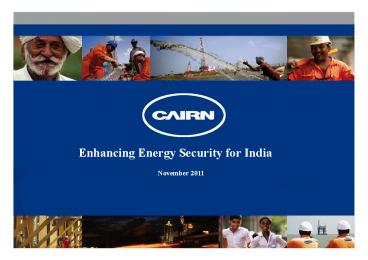Cairn India - Enhancing Energy Security for India
Title:
Cairn India - Enhancing Energy Security for India
Description:
India is the world’s 5th largest importer of oil in 2010, importing ~75% of its oil needs. At US$ 103/bbl, India’s oil import bill would increase by US$ 20 bn in 2012. For India to Secure Oil for Sustaining Growth the options are 1. Domestic Exploration Efforts need to be Stepped Up. 2. Overseas Oil Equity: Natural Hedge against Increasing Prices. 3. Demand Management required to reduce Oil Intensity. – PowerPoint PPT presentation
Number of Views:523
Title: Cairn India - Enhancing Energy Security for India
1
Enhancing Energy Security for India
November 2011
2
2
Disclaimer
These materials contain forward-looking
statements regarding Cairn India, our
corporate plans, future financial condition,
future results of operations, future
business plans and strategies. All such
forward-looking statements are based on our
management's assumptions and beliefs in the
light of information available to them
at this time. These forward-looking
statements are, by their nature,
subject to significant risks
and uncertainties and actual results,
performance and achievements may be
materially different from those expressed
in such statements. Factors that may cause
actual results, performance or achievements
to differ from expectations include, but are
not limited to, regulatory changes, future
levels of industry product supply, demand
and pricing, weather and weather related
impacts, wars and acts of terrorism,
development and use of technology, acts
of competitors and other changes to
business conditions. Cairn India
undertakes no obligation to revise any such
forward-looking statements to reflect any
changes in Cairn Indias expectations with
regard thereto or any change in circumstances or
events after the date hereof.
3
3 Indias Dependence on Imports to meet
Oil Demand to Grow Imports
India worlds 5th largest importer
of oil in 2010, importing 75 of its oil
needs Source
Domestic Production - BP Statistics (actual),
Infraline (forecast) Projected demand _at_ 2.8CAGR
- EIA Annual Energy Outlook 2011 OVL overseas
equity oil production, forecast _at_ 2.8 CAGR
4
4
Increasing Impact on Economic Growth from Oil
Import Bill
Source PPAC, Bloomberg, World Bank, FY12 GDP
growth _at_7.5
? IEA forecasts average crude price of US
103/bbl from 2011-2015, compared to US
79/bbl over 2006-2010
? At US 103/bbl, Indias oil import bill would
increase by US 20 bn in 2012
5
5
Options for India to Secure Oil for Sustaining
Growth
1. Domestic Exploration Efforts
2. Acquisition of Overseas Oil Equity
3. Demand Management
6
6
Domestic Exploration Efforts need to be Stepped Up
? Only 22 of Indias sedimentary basin area is
well explored
? Nine NELP rounds held so far, with one large
discovery
? Intensity of exploration activities must
increase
? Capital and technology required role of
private sector will therefore be critical
? Supportive policy and fiscal environment key
to attracting investment
7
7 Cairn India Rajasthan Enhancing Indias
Energy Security Indian Crude Consumption
2009-2010
? Largest oil discovery in India since 1985 ?
First Oil in August 2009, now
producing at 125,000 bopd ? Innovative
technology applications ? At current
envisaged basin potential of 240,000 bopd,
production from Rajasthan will
Imported 79 Domestic 21 Oth
er Domestic 65
? Contribute 35 of Indias domestic
production Rajasthan
20
Rajasthan 35
? Offset Indias crude oil import dependency
by
7 Imported Domestic Quantity MOPNG
Data Future Assuming Indian production remains
at current levels of 2009-10.
8
8 80 of Value accrues to the
Government Value Split RJ-ON-90/1
PSC Rajasthan ?In-place resource base of 4 bn
bbls with additional risked exploration
potential of 2.5 bn bbls
? 80 of value potentially US 100
bn accrues to the Government Ravva ?Recoverab
le resources tripled, expect to achieve gt 60
recovery ?gtUS 5 bn paid as profit petroleum
to Government
Government 80 (GoI, GoR, NOC) Cairn
20
9
9 Overseas Oil Equity Natural Hedge against
Increasing Prices Options
Inorganic Growth (Discovered
Resources) Advantages - Quicker to
Production - Low Risk Disadvantages - Costlier
than organic growth - Competition for assets is
high
Organic Growth (Greenfield Exploration) Advan
tages - Finding costs lower - Competition is
less intense Disadvantages - Longer lead
time - Higher Risk
Potential for public and private sector companies
to collaborate and share risks
10
10 Demand Management required to reduce Oil
Intensity
Oil Intensity (Oil Consumption per unit of 2009
GDP)
? Indias crude oil intensity is high relative
to developed and emerging economies ? Policy
efforts required to bring structural shift
away from oil in key sectors
transport and industry ? Japans 2006
National Energy Strategy includes ambitious
targets ? Reduction in ratio of oil to entire
primary energy supply to lt40 by 2030 ?
Reducing oil dependence in transport sector
to 80 by 2030
? Improve
coordination
with
other
oil
Source Morgan Stanley
consuming nations on use of
Strategic Petroleum Reserves
11
11 Conclusions
What do we need to do?
Where are we today?
? Policy interventions required ? National
Energy Policy required to set ? Long term
vision and short term goals ? Roles and targets
for Private and Public sector ? Establish
National Energy Council to ? Raise energy
security on our national agenda ? Catalyze
coordinate Public/ Private initiatives
? ? ? ?
Cost of oil will continue to rise Indias oil
demand will continue to grow with its
economy Gap between domestic production
and demand expected to increase To bridge the
gap, we need to act now
Coordinated action between public and private
sector key to meeting challenges































